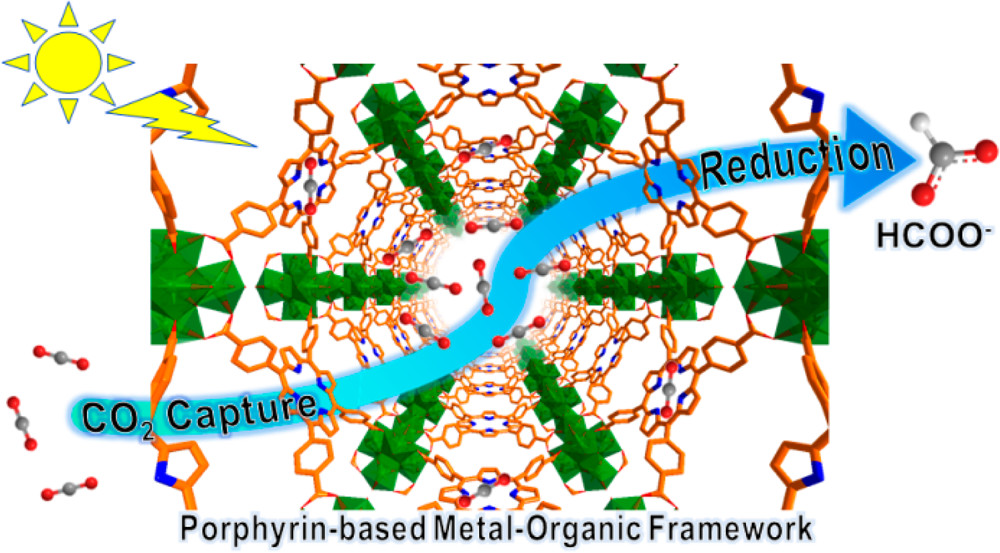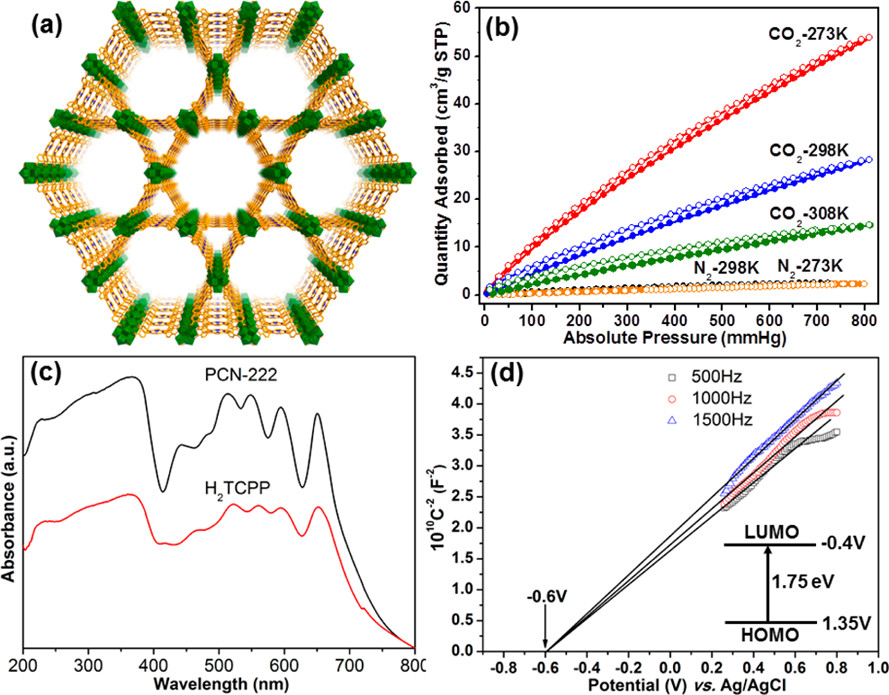Home >
News > Visible–Light Photoreduction of CO₂ in A Metal–Organic Framework: Boosting Electron–Hole Separation via Electron Trap States
Visible–Light Photoreduction of CO₂ in A Metal–Organic Framework: Boosting Electron–Hole Separation via Electron Trap States
Summary:
The authors from University of Science and Technology of China and Fuzhou University developed a porphyrin-involved metal-organic framework (PCN-222) with high CO₂ adsorption capacity and visible-light responsiveness, achieving efficient and selective photoreduction of CO₂ to formate anion in the field of CO₂ photocatalytic conversion.

Background:
1. To address excessive CO₂ emissions from fossil fuel dependence and the low efficiency of existing CO₂ photoreduction catalysts (e.g., TiO₂-based catalysts only work in UV region and have weak CO₂ adsorption), previous researchers explored semiconductors, metal-incorporated zeolites, and metal complexes, but most molecular systems rely on expensive noble metals, and MOF-based CO₂ photoreduction studies are rare with unclear mechanisms.
2. The authors proposed using a stable mesoporous zirconium-porphyrin MOF (PCN-222) to integrate CO₂ capture and visible-light-driven photoreduction, and revealed the mechanism via ultrafast spectroscopy, achieving much higher catalytic activity than the pure H₂TCPP ligand.
Research Content:
1. Synthesis
-H₂TCPP synthesis: First, pyrrole and methyl 4-formylbenzoate were refluxed in propionic acid for 12 h to obtain the ester form of H₂TCPP, which was then hydrolyzed with KOH in THF/MeOH/H₂O mixed solvent and acidified with 1M HCl to get the acid form of H₂TCPP.
-PCN-222 synthesis: ZrCl₄, H₂TCPP, and benzoic acid were ultrasonically dissolved in DEF, heated in a Teflon-lined bomb at 120 ºC for 48 h and 130 ºC for 24 h. The product was activated with HCl/DMF, washed with DMF/acetone, and dried at 120 ºC in vacuum.
2. Characterizations
1.BET and pore size: PCN-222 has a BET surface area of ~1728 m²/g and 1D large channels with a diameter of 3.7 nm; its CO₂ uptake is 14, 35, and 58 cm³/g at 308, 298, and 273 K (1 atm), while N₂ adsorption is negligible at 273/298 K.
2.SEM tests: FE-SEM images show PCN-222 has a rod-like shape and micrometer-scale size.
3.Other tests:
- UV-Vis spectra: PCN-222 absorbs 200–800 nm light, inheriting H₂TCPP’s visible-light absorption.
- Mott-Schottky plots: PCN-222 is an n-type semiconductor with a flat band potential of ~-0.60 V vs Ag/AgCl (-0.40 V vs NHE) and a band gap of 1.75 eV (Tauc plot).
- XRD: PCN-222’s structure remains intact after photocatalysis.
3. Application
PCN-222 was tested for CO₂ photoreduction in MeCN/TEOA (10:1 v/v) under 420–800 nm visible light (300 W Xe lamp). Results:
- 30 μmol of HCOO⁻ was produced in 10 h, 12.5 times higher than H₂TCPP (2.4 μmol).
- Selectivity for HCOO⁻ is 100% (no H₂, CH₄, CO, or alcohols detected).
- Good stability: No activity loss in 3 consecutive 10-h runs.
4. Mechanism
-Electron transfer path: Visible light excites H₂TCPP (light-harvesting unit) to an excited state, which transfers electrons to Zr₆ clusters, reducing Zr⁴⁺ to Zr³⁺ (detected by ESR). Zr³⁺ then reduces CO₂ to HCOO⁻, and TEOA (electron donor) is oxidized to aldehyde (detected by ESI-MS) to complete the cycle.
-Efficiency reason: PCN-222 has a deep electron trap state that suppresses electron-hole recombination (confirmed by steady-state PL (PL quenching) and ultrafast TA spectroscopy: two short lifetimes (18 ps, 190 ps) for trap states and an ultra-long lifetime for deep traps), providing long-lived electrons for CO₂ reduction.

Outlook:
This research is the first to realize visible-light-driven CO₂ photoreduction using a porphyrin-based semiconducting MOF (PCN-222). It clarifies the electron-transfer mechanism in MOFs, highlights the advantages of assembling photoactive molecules (e.g., porphyrins) into MOFs for CO₂ conversion, and provides a basis for developing efficient visible-light-responsive MOFs for solar-driven CO₂ capture and reduction.
Visible–Light Photoreduction of CO₂ in A Metal–Organic Framework: Boosting Electron–Hole Separation via Electron Trap States
Authors: Hai-Qun Xu, Jiahua Hu, Dengke Wang, Zhaohui Li, Qun Zhang, Yi Luo, Shu-Hong Yu, Hai-Long Jiang
DOI: 10.1021/jacs.5b08773
Link: https://pubs.acs.org/doi/10.1021/jacs.5b08773
The above review is for academic progress sharing. For any errors or copyright issues, please contact us for correction or removal.

